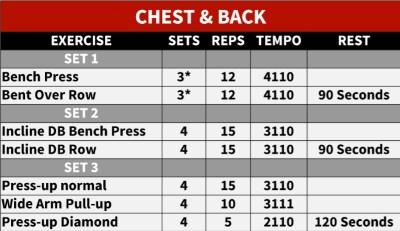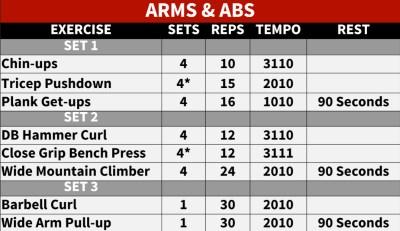Looking for a FREE, 3-day split workout?
You’re in the right place…
PLUS…Get my muscle building meal plan guide
Get Ripped 3 Day Split Routine
Follow these key points to add up to 1kg of muscle per month:
- Quality over quantity – NEVER sacrifice technique to lift a heavier weight
- TEMPO – Training with tempo is critical to building muscle (explained here)
- Supersets – Used to get better results and save time (explained here)
- Buddy – Train with a partner. No partner? Use machines instead of free weights so you can go to failure safely
Note: To build lean muscle, going to failure with CORRECT and CONTROLLED technique is essential.
Your Weight Training Plans
Complete each workout once per week
If you have extra time, do the legs workout twice
Click the workout plans above to open a PDF. If you have an iPhone you can save it in iBooks.
“Tempo” and “dropsets” are explained in my “Ultimate Guide to Working Out”, below.
Select Your HIIT Session
Pick 1 HIIT session to complete per week. You can mix and match.
Feeling energetic? Do it twice!
HIIT #1
Legs & Core 1
HIIT #2
Upper Body
HIIT #3
Legs & Core 2
HIIT #4
Full Body
How to schedule you workouts
Note: Fasted cardio is optional, but will get you leaner, quicker
To do it, use a stationary bike for 30 mins before breakfast, keeping heart rate at 60-70% max (220 – your age)

Note: Avoid training the same muscles on back-to-back days. Recovery is as important as the workout to build muscle
WHAT’S POSSIBLE?
My clients below used the this training system. It’s simple, yet effective
Check out “Bonus #1” below to hack your way to a better body starting today

Lost 6.8kg
Dropped 7% body fat
Matt is a busy consultant who’d let things slip over the years.
He wasn’t eating well, drank alcohol a few times a week and didn’t exercise regularly.
We trained 4 times a week, mainly weight training, to build muscle and burn fat.

Lost 4kg
Dropped a jean size
After having children, Mary wanted to get back into shape.
We didn’t train together, but we keep in constant contact over Whatsapp.
With guidance on exercise and nutrition, Mary was able to make excellent progress.

Lost 4.5kg
Dropped 3 inches off waist
Steve came to see me with low energy and unsure of how to make progress.
We followed my body transformation program to the letter.
He made some small changes to his eating habits to produce great results.
#Bonus: Muscle Building Meal Plan
Here’s an example meal plan to get you started
Click the image above to get the PDF
Videos of how to make all meals are included
If you’re interested in super-charging your recovery and health, check out the newest super-supplement to hit the market which is CBD. Read my CBD Guide for a genuine, highly researched post which includes Medterra, Truth Naturals and Hempura discount codes.
If you’ve ever suffered from Rosacea or dermatitis, I just wrote a post about Azelaic Acid (before and after pics) which has literally changed my life. Bit embarrassing to share but it is what it is.
SECTION 1
HOW TO TRAIN EFFECTIVELY
Effective Gym Training Strategies
Unlock the secrets all the pros use to build muscle like a machine!
Learn about split routines, compound moves, periodisation and …
…Why cardio is key!
Topics covered in this section
Why Split Routines are Effective
Split routines are very effective if you train often enough.
If training 2 x a week, you’re probably better off with 2 full body workouts because you need to work all the muscles each time.
Consistently train 3 or more times per week?
Make the switch to a split routine such as the one above.
Being able to focus on body parts, such as chest, back, legs, etc will mean you can get more out of each session.
A more focused session will mean more exercises for each muscle, meaning more overload.
More overload = more muscle!
Body Part Weight Training
This is also known as a split workout plan, as mentioned above.
In short it means targeting a specific set of body parts per workout. Common splits include:
- Legs & Shoulders
- Chest & Biceps
- Back & Triceps
There are a lot of ways you can split your workouts to focus on individual body parts, depending on how much time you have and how advanced you are.
Within each workout you may target each body part with 2 to 4 different exercises. This allows you to really target each area specifically.
Body part training is more of a body building concept, because the focus is on building aesthetically pleasing muscle by increasing its size and definition.
Why Cardio Must be Included
Often you find people in one of two camps. They either love weight training and hate cardio, or hate weight training and love cardio.
The key is to love both!
Here’s the thing. If you want to look like an athlete, or as near as you can realistically get, you have to train like one.
Athletes will do weight training, stretching, steady state cardio and HIIT style sessions.
Cardio helps maintain your cardiovascular system – heart, lungs and blood vessels.
It also helps burn calories and gives your muscles a nice lean, functional look.
The best amount of cardio to do?
I’d recommend 1 x HIIT session and 1 x steady state cardio session per week.
In addition to your 2-3 x weight training sessions.
I’ve said it before and I’ll say it again, 4 x a week training is the sweet spot for muscle growth, fat loss and fitness.
Compound & Isolating Exercises
Compound exercises are those which use multiple muscle groups at the same time. For example, deadlift, bench press, pull-ups, chin-ups, squats.
Isolating exercises are those which focus on a single muscle group. For example, bicep curl, tricep extension, calf press.
Compound vs Isolated Weight Training
When you should use them is a good question.
In general, compound moves are great when you only have 1-2 sessions a week to train because they hit lots of muscles all at once.
Isolated exercises are perfect when you have 3+ days per week to train and want to really target specific muscles.
Can you mix them..?
Yes, you can. Most workouts will include compound moves as the base and isolating exercises on top.
Start off with compound moves, to work the bigger muscles and then add some isolating moves to finish them off.
Example compound and isolating moves…
If you’re working the back & biceps, you might do the following:
- Wide arm pull-ups
- Seated row
- Bicep curls
This first targets the larger muscles of the back, while also using the biceps and forearms.
Then targets the biceps with a specific isolating move to finish them off.
Functional Training
Functional training became ‘the in thing‘ many years ago now, but it’s what athletes have been doing for years.
Any football, rugby or fighter will incorporate this style of training into their routine because it’s rooted in real world movements.
Why is weight training not functional?
Typical weight training is not very functional because the movements you make don’t reflect how you move in sport.
For example, squats and deadlifts are not the kind of movement you’d do on a football pitch.
In most sports, there is much more dynamic movement where the whole body is used not just a small set of muscles in one direction.
So what’s functional training then?
Things like box jumps, renegade rows, lunges in different directions are all functional because they are more similar to what you’d do on a sports field or in a game.
Should I add functional training to my workout?
It depends on your goal. If your only goal is to build muscle to look good, it’s not that necessary.
If you want a strong, fit and well functioning body then yes you definitely should.
High Intensity Interval Training
HIIT training is an ideal way to get a fast cardio and muscular workout when you’re short on time.
Done right, it can push you very hard physically, which in turn helps you get fitter, stronger and leaner.
What is HIIT?
I’ve defined what HIIT is below, but I’ll quickly recap and then cover some practical examples of it.
HIIT is timed intervals of high intensity activity followed by rest or lower intensity intervals.
The intervals can vary in length. For example, Tabata is the most famous HIIT protocol. Which looks like this:
20 seconds 100% effort, followed by 10 seconds rest. Repeat 8 times.
Should I include HIIT?
For most people the answer will be yes.
HIIT helps get you fitter and stronger and works you in a way that steady state and weight training can’t do alone.
My free to download workouts above include 1 HIIT session per week.
Most gyms have HIIT classes now so you could just go along to one of those.
HIIT is something where you will benefit from training with others, as doing it alone you will not push yourself hard enough.
SECTION 1 FAQs
The science is not good enough to know for sure. The end result is this: Doing cardio will burn energy so if you are looking to lose weight, no cardio is bad.
Will fasted cardio burn more than normal cardio? Hard to tell. I like doing it because I believe there are 3 other reasons other than faster fat burning that make it really effective.
It depends on your goal. If you are looking to gain muscle mainly for strength and to look better, go with split routines 3 or 4 days a week.
If you’re more interested in general health, fitness and all round athletic ability then full body workouts are a good option. If you’re training multiple days in a row, try to avoid doing too much on each muscle group each day.
SECTION 2
HOW TO MAXIMISE MUSCLE
Proven Techniques to Build Lean Muscle
Knowledge is power…Power comes from learning to lift properly.
This section covers rep ranges, using time under tension, tempo and…
…A whole lot more!
Topics covered in this section
Best Rep & Set Ranges for Building Muscle
It’s the topic most people go to when talking about weight training…How many sets and reps should I do?
The thing is, no two reps and sets are the same…How quickly (tempo) you move the weight will change the feel and result massively.
We’ll talk about that in a moment, but first let’s look at the common rep ranges:
- Reps: 4 to 6 – The rep range for building strength, not necessarily with much size gain
- Reps: 8 to 12 – The most common rep range for building muscle (hypertrophy)
- Reps: 15+ – Thought about as more muscular endurance training
What about speed of movement?
Two people (Dave & Steve) are both doing 10 reps of bench press on 60kg. Which one builds the most muscle?
No, this is not some cryptic puzzle for you to solve…
The answer is: It will depend on each person’s speed of movement. The speed they lower, pause and push the bar. Also known as Tempo.
Let’s see how they lift…
Dave lowers the bar for 1 second, doesn’t pause and pushes for 0.5 seconds. This is probably typical of most people in the gym.
Steve lowers for 2 seconds, pauses for 1 second and pushes for 1 second.
How do the two compare?
- Dave put his muscles under 15 seconds of tension (Time Under Tension)
- Steve put his muscles under 40 seconds of tension
There’s a big difference here. Steve’s set is almost 3 x Dave’s set in terms of time under tension!
Same exercise, same weight, very different load on the muscles. This is key because extra load on muscle = muscle growth.
What that means for you…
Depending on your goal, you may want to think about how quickly or slowly you lift weights.
Always lifting fast means you get to use momentum which reduces the load on your muscles.
If you want to build muscle, understanding Time Under Tension (TUT) and Tempo is critical.
Here is an example from the bench press of a good muscle building number of sets, reps and tempo:
- Use a 3 second eccentric phase (lowering), pause for 1 second, 1 second concentric phase (pushing), pause at the top for 1 second
- Complete 4 sets of 12 reps
If you’re used to “normal” tempos you will definitely need to lower the weight to start with.
Put your ego aside. Lifting very heavy is not usually necessary.
SECTION 2 FAQs
Both high reps and low reps can build muscle. The more pertinent questions are to do with tempo and time under tension (TUT).
You could do 15 reps very quickly or 5 reps very slowly and both produce the same amount of TUT. The more TUT you place on your muscles, the more load they endure which results in your muscles getting bigger (hypertrophy).
SECTION 3
EATING TO BUILD MUSCLE
Abs are made in the kitchen…
They say a great body is 80% diet and 20% training. I’d have to agree.
Learn how to eat well today to build bigger muscles tomorrow, and the day after…
Listen up!
Topics covered in this section
SECTION 3 FAQs
SECTION 4
HOW TO BUILD WORKOUTS
Learn how to build your own workouts
Give a man a workout, he’ll be able to train.
Teach a man how to build a workout and he’ll build muscle for life!
Remember, knowledge is power.
Topics covered in this section
SECTION 4 FAQs
SECTION 5
A WINNING MINDSET
Discover hacks and mindset shifts
Hopefully you’re open to the idea that training is more than just about muscle.
Building confidence and understanding your motivations will help you in every aspect of life.
Let’s look at a deeper level.
Topics covered in this section
SECTION 5 FAQs
SECTION 6
JARGON BUSTING
Taking the term out of terminology
Acronyms are great if you know what they mean…
This section will arm you with the weight room lingo so you don’t look like a lemon.
Let’s talk tempo, supersets and pyramids
Topics covered in this section
What is Tempo?
If you’ve ever read any workout guide, you will probably have heard the term “tempo” mentioned. What does it mean? Allow me to explain…
In short, tempo is the speed you move. In weight training it means how fast or slow you lift and push the weights.
It will often look like this “Bench Press 4 x 12 reps, tempo: 3-1-1-0”
Let’s dissect that…
The tempo in this case of the bench press means the following:
- 3 seconds to lower the bar
- 1 second pause at the bottom
- 1 second to push the bar up
- 0 second pause at the top
There are 4 phases to every movement; up, pause, down, pause.
Usually the first number will be for the eccentric phase. That’s lowering in bench press and most movements, but in other moves will be where you are not contracting the muscles.
What is Time Under Tension?
In short, it means how much work you are doing per set and can be calculated like this:
Time Under Tension (TUT) = Reps x Tempo
Let’s look at the good old bench press as an example…
12 reps, tempo 3010…So that’s 4 seconds per rep x 12 reps = 48 seconds TUT
The higher the TUT, the more load on your muscles and the more they will grow.
What is Hypertrophy?
It means to build muscle. Simple.
Hyper always means bigger, better, faster, etc. For example…
- hyperactive – annoying people…
- hyperoptic – really fast broadband
- hypertension – high blood pressure
- hyperspeed – very fast
I think you get the picture. Hyper is usually good. Now get hyper-working-out!
What is Steady State Cardio?
Steady state cardio is where you perform exercise, which raises your heart-rate, at a consistent (steady) speed or intensity.
Typical examples are running, cycling and swimming and would last anywhere from 20 mins to 1 hour or more.
It’s often used when doing fasted cardio because it’s seen as a way to burn fat rather than using stored carbohydrates (glycogen).
What is HIIT?
HIIT stands for High Intensity Interval Training. It is exercise performed for timed intervals of higher and lower intensities.
For example, you might sprint for 60 seconds and jog for 30 seconds. That would be 1 round and you may complete 4-10 rounds.
A very famous and common HIIT protocol is Tabata, where you perform 20 seconds at 100% effort followed by 10 seconds rest.
A Tabata workout is incredibly hard if done correctly. Using a stationary bike is a really good way to do it.
What are SuperSets?
Supersets are simply two or more exercises done one after the other without rest between.
Let’s say you do bench press followed by bent over row without taking a break.
That’s a superset. You have completed each one back-to-back.
SECTION 6 FAQs
Tempo in fitness is different to tempo in weight training, although they both refer to the speed at which you train.
In fitness, specifically running, tempo means to run at a speed which is you’d consider running at your lactate threshold (85% of maximum heart rate for most) or anaerobic threshold. This means the pace you can just about hold without burning out for the given distance.
Whether it’s 3km, 5km or 10km a tempo run for those distances means running at a pace you are just able to hold for the total distance.
Not everyone agrees on the same definition as it has come to mean different things to different people over the years. But this is my understanding of it.
In weight training, tempo refers to how quickly you move the weight. A 3010 tempo means you take 3 seconds in the eccentric phase (usually lowering), 0 second pause at the bottom (isometric phase), 1 second in the concentric phase (pushing usually) and a 0 second rest at the top (can also be isometric).
Check out this detailed description for more insights about tempo training with weight lifting.


